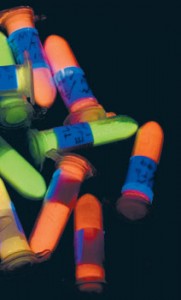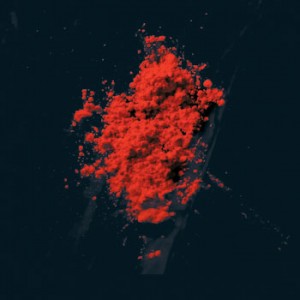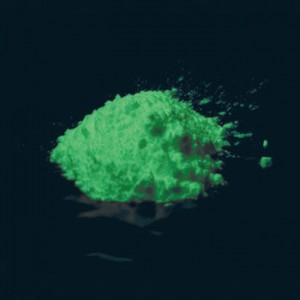
EDUARDO CESARRare earth elements: compounds of chemical elements emit color when illuminatedEDUARDO CESAR
Currency bills coated in extremely fine and translucid polymer films may become the latest solution to guarantee the authenticity of a country’s currency. When illuminated with ultraviolet light, for example, the currency bill emits a red light in response, thus confirming the bill’s veracity. This technological resource, which can be extended to other easily-counterfeited documents, such as passports, identity cards, driving licenses and official documents, is in the course of being patented by the Agência USP de Inovação, Innovation Agency, responsible for patents at the University of São Paulo. The group of inventors is headed by chemist Hermi Felinto de Brito, a professor at USP’s Chemistry Institute, who has been working with rare earth elements since the 1980s. Rare earth elements are the raw materials that are part of these polymer films.
Rare earth elements are actually metals; they comprise a group of 15 elements known as lanthanides – which include Lanthanum (La) and Lutetium (Lu) in one file in the Periodic Table – plus two other elements – Scandium (Sc) and Yttrium (Y). The term “rare” was ascribed to this group of elements because when the first metals in this group – which have very similar properties and are difficult to distinguish from other elements – were discovered in the 18th century, they were found only in Scandinavia. Nowadays, they are found all over the world. In Brazil – the world’s 10th largest producer – they are commonly found in the Monazite sands on the beaches in Brazil’s Southeast Region. The term “earth” is used because initially these elements had been isolated in the form of oxides, together with oxygen, substances which in those times were called “earths”. Although not widely used, these elements have luminescent properties and are used, for example, in fluorescent lamps, medical diagnosis equipment, and to form images on, TV and computer screen and mobile phone displays. Although they provide color to TV screens, these rare earth elements are not very colorful in their natural state. Normally, their colors vary from dark grey to silver hues; these metals are soft and flexible. They become more attractive when they are in the form of ions (atoms or molecules that have lost electrons) for some technologies, because of their capacity to emit colored light after being submitted to a source of illumination, such as electromagnetic radiation (X-rays ultraviolet rays, visible light, infrared rays), electron beams, heat, electricity, mechanical energy, chemical or biological reactions.
 EDUARDO CESARWhen some of these elements of this rare earth group – such as Europium (Eu), Terbium (Tb) and Thulium (Tm), – are in the form of ions and are submitted to ultraviolet light, they emit the primary colors – red, green and blue, respectively. “In order for a material to emit light, it first has to absorb enough energy from the source of illumination”, says Brito, to achieve, for example, the phenomenon known as luminous persistence, which occurs when the electrons of these materials, upon being illuminated, absorb and accumulate the energy they receive. After illumination ceases, the elements relax and go back to their normal state, releasing the excess energy they acquired in the form of photons, which comprise the visible light, or the colored light emitted by the material. This emission occurs in one of two ways: a quick way, called fluorescence, where the entire process occurs in a very short time (measured in nanoseconds) and another slower way, phosphorescence, which can persist for a longer period of time, ranging from milliseconds to hours.
EDUARDO CESARWhen some of these elements of this rare earth group – such as Europium (Eu), Terbium (Tb) and Thulium (Tm), – are in the form of ions and are submitted to ultraviolet light, they emit the primary colors – red, green and blue, respectively. “In order for a material to emit light, it first has to absorb enough energy from the source of illumination”, says Brito, to achieve, for example, the phenomenon known as luminous persistence, which occurs when the electrons of these materials, upon being illuminated, absorb and accumulate the energy they receive. After illumination ceases, the elements relax and go back to their normal state, releasing the excess energy they acquired in the form of photons, which comprise the visible light, or the colored light emitted by the material. This emission occurs in one of two ways: a quick way, called fluorescence, where the entire process occurs in a very short time (measured in nanoseconds) and another slower way, phosphorescence, which can persist for a longer period of time, ranging from milliseconds to hours.
However, for this to occur, researchers have to deal with another property of the rare earth ions. “They have a low molar absorption coefficient, that is, they absorb a little energy from the illumination sources”, Brito explains. “To overcome this deficiency, we use ligants such as anions (organic molecules) or neutral molecules considered as donors of pairs of electrons, with the objective of collecting light efficiently”. In practical terms, the rare earth ion is surrounded by organic molecules, such as dicetonates, carboxylates, and sulphoxides. These ligants absorb the stimulated energy more efficiently and transfer it to the rare earth ion which then releases the energy in the form of colored light.
Less expensive
According to Brito, the number of research projects on the photo luminescence of rare earth elements has increased significantly around the world, due to the promising optical properties of these systems. “Various compounds of these metals are already being applied; therefore, one must take into consideration the molecular design study (synthesis) that is behind these products”, says Brito. The fact that these elements have become less expensive has also contributed to the rising scientific and technological interest in these materials. “Ten years ago, rare earth compounds were very expensive, but now the price has dropped significantly”, he explains. “In our research studies, we normally use the doping system (only 1% rare earths), which also makes the product less expensive”. Thulium, the least abundant element in this series, is more common in nature than gold, silver and platinum. For the purpose of comparison, it is widely believed that the earth’s crust contains 0.02% lanthanides and 0.00002% silver. Thus, thulium is one thousand times more abundant than silver.
 EDUARDO CESARAt USP, Brito’s strategy is to prepare a series of new, highly luminescent rare earth compounds that can be used as light-emitting molecular devices. All in all, Brito and his group have already created and tested approximately 200 compounds made from these elements, such as Europium, Terbium and Thulium. They combine the first two elements with a plastic and produce a film or fine film. “This doped polymeric film has ‘dual color’ characteristics which, under different kinds of radiation and different wave lengths, emits distinct colors”, Brito explains. “When this film is illuminated with an ultraviolet lamp, the wave length of which is short (255 nanometers), it emits a green color. If the stimulation is caused by a longer wave length (365 nanometers), it emits a red color”. One of the advantages of this dual color system is that it can be used to identify the legitimacy of documents in a more secure and accurate manner because it has two optical markers inside the same system.
EDUARDO CESARAt USP, Brito’s strategy is to prepare a series of new, highly luminescent rare earth compounds that can be used as light-emitting molecular devices. All in all, Brito and his group have already created and tested approximately 200 compounds made from these elements, such as Europium, Terbium and Thulium. They combine the first two elements with a plastic and produce a film or fine film. “This doped polymeric film has ‘dual color’ characteristics which, under different kinds of radiation and different wave lengths, emits distinct colors”, Brito explains. “When this film is illuminated with an ultraviolet lamp, the wave length of which is short (255 nanometers), it emits a green color. If the stimulation is caused by a longer wave length (365 nanometers), it emits a red color”. One of the advantages of this dual color system is that it can be used to identify the legitimacy of documents in a more secure and accurate manner because it has two optical markers inside the same system.
According to Brito, in addition to the capability of emitting two colors, the thermal stability and the ease with which this polymeric film doped with rare earth ions is processed, makes it an attractive material for a number of applications, such as photonic markers. Brito says that the two-color polymer film patent filed by USP at the Instituto Nacional de Propriedade Industrial/INPI Patent Granting Agency has drawn the attention of technicians from the Central Bank who have already manifested their interest in becoming acquainted with this technology to explore the possibility of using it to mark R$ currency bills. Brito adds that Euro currency bills already have these markers, with different compounds.
The Project
Photo luminescent preparation and study of the luminous persistence of materials doped with rare earth ions (nº 05/01216-0); Modality Regular Research Awards; Coordinator Hermi Felinto de Brito – USP; Investment R$ 191.572,77 and US$ 6.076,94 (FAPESP)